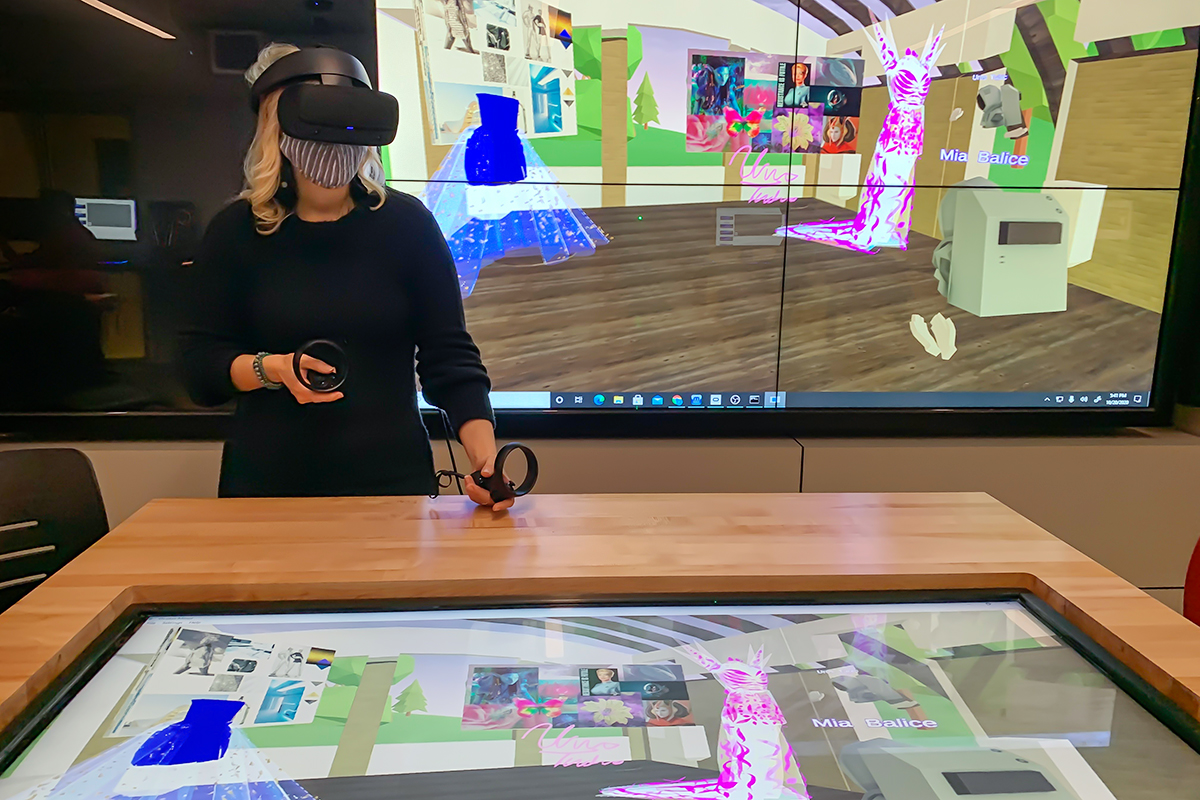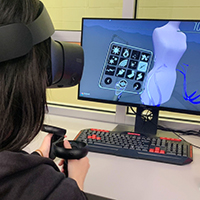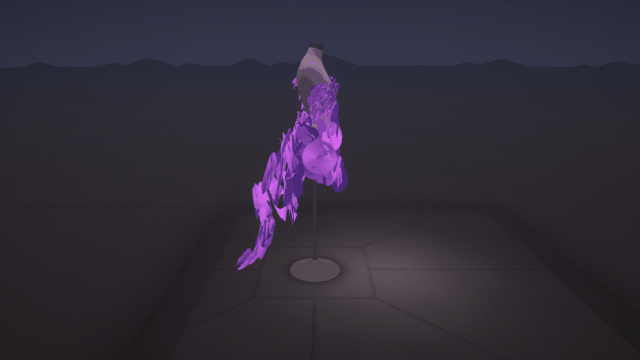
Art professor Chiara Vincenzi uses Komodo, a virtual reality program being developed by the IDEA Lab at Illinois, to offer critiques of dress designs created by her students. Vincenzi used a program that allowed students in her fashion illustration class to design in the virtual world.
Courtesy CITL Virtual Reality Lab and Innovation Studio
CHAMPAIGN, Ill. — Students in Chiara Vincenzi's fashion illustration class designed glamourous evening dresses using a virtual palette and brushes as they moved around a mannequin in the virtual world.
Vincenzi, an art and design professor at the University of Illinois Urbana-Champaign, wanted to introduce her students to a new approach to exploring fashion design. Their project for the fall semester was to design a collection of garments, most of which they drew using pencils and paper or programs such as Adobe Illustrator. For an assignment to create a red-carpet dress, though, the students donned virtual reality goggles and used Google Tilt Brush, a 3D-painting VR application.
"When you're in virtual reality, you can create freely, try different forms and shapes, experiment and try several options," Vincenzi said.
The professor and her students used the Virtual Reality Lab and Innovation Studio operated by the Center for Innovation in Teaching and Learning. The spaces are part of VR@Illinois, a partnership between CITL, the University Library and Technology Services to support virtual, augmented and extended reality teaching and research. VR@Illinois also includes the Media Commons in the Undergraduate Library and the IDEA Lab in the Grainger Engineering Library.

A student uses the tools in the virtual reality program Google Tilt Brush to create a dress design.
Courtesy CITL Virtual Reality Lab and Innovation Studio
Vincenzi used the Media Commons to create a tutorial showing students the virtual reality world of Tilt Brush before they began using it in the lab. Their time in the lab was limited because of COVID-19 restrictions; the class met twice in small groups, with one session to experiment with Tilt Brush and a second session to complete the dress designs.
Vincenzi said the VR program makes the design process more flexible and spontaneous, and allows users to see their creations in different dimensions.
"It's very suitable for the first stage of ideation of a fashion garment. Students can go around the mannequin and explore shape, colors, texture and different silhouettes," she said. "I've sometimes seen students who came to the virtual reality lab with sketches and then when they are in virtual reality, they start with that idea and they end up with something very different."
Using a VR program is challenging at first for students who are accustomed to traditional tools and cannot achieve the same result with Tilt Brush as they can with pencils, Vincenzi said.
Mia Balice, a junior studying communication and minoring in art and Spanish, said she took the class because she likes drawing dresses. She had never used virtual reality before.
"It was hard trying to get the right material for the dress. There were a bunch of different brushes you could use, but some wouldn't form together, and sometimes the brush wouldn't touch the mannequin and the dress would be kind of floating off of it a little," Balice said. "There were some really fun ones, like glitter brushes and sparkle brushes. The biggest challenge was finding something that would look the most like a dress."
Balice said being able to see all sides of the dress on the mannequin made it feel more real, and it was fun to experiment with the program.
"If you don't like what you have, with the click of a button, you can erase everything or delete one section," she said. "It was a very cool experience."
Since the spaces opened three years ago, they have drawn interest from faculty members across campus who see the potential for experiential learning for their students, said Jim Wentworth, the associate director for education innovation at CITL and the director of the Virtual Reality Lab and Innovation Space. While the most common uses of the Virtual Reality Lab involve passive viewing of a virtual environment, some professors program their own 360-degree environments to suit very specific needs. Vincenzi is the first professor to use a commercially available, free program that allows students to create in a virtual reality environment, Wentworth said.
She also used a program called Komodo, being developed at the IDEA Lab, that allows users to import existing 3D content and view it in virtual reality. The program enabled Vincenzi and her students to view and critique their designs in the same virtual reality room.
Vincenzi hopes to expand the use of virtual reality in her classes.
"Especially in this moment with COVID-19, designers are trying different ways to propose collections because people can't meet for fashion shows. It's an interesting way right now to make a virtual reality fashion show," she said.

A student's dress design, created in virtual reality using Tilt Brush.
Courtesy CITL Virtual Reality Lab and Innovation Studio






